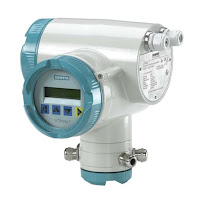Happy Holidays from all of us at Ives Equipment! Here's to a great 2019!
Educational information on process control, industrial instrumentation, valves, valve automation and control valves. For additional information visit IvesEquipment.com or call 877-768-1600
Understanding HART Communication Protocol
A technological advance introduced in the late 1980’s was HART, an acronym standing for Highway Addressable Remote Transmitter. The purpose of the HART standard was to create a way for instruments to digitally communicate with one another over the same two wires used to convey a 4-20 mA analog instrument signal. In other words, HART is a hybrid communication standard, with one variable (channel) of information communicated by the analog value of a 4-20 mA DC signal, and another channel for digital communication whereby many other variables could be communicated using pulses of current to represent binary bit values of 0 and 1. Those digital current pulses are superimposed upon the analog DC current signal, such that the same two wires carry both analog and digital data simultaneously.
Looking at a standard loop-powered (2-wire) process transmitter circuit, we see the transmitter, a DC power supply (voltage source), and usually a 250 ohm resistor to create a 1 to 5 volt signal readable by any voltage-sensing indicator, controller, or recorder:
The transmitter’s primary function in this circuit is to regulate current to a value representative of the measured process variable (e.g. pressure, temperature, flow, etc.) using a range of 4 to 20 mA, while the DC voltage source provides power for the transmitter to operate. Loop-powered instruments are very common in industrial instrumentation because they allow both power and (analog) data to be conveyed on the same pair of wires.
With the advent of microprocessor-based process transmitters, it became possible for instrument technicians to digitally configure parameters inside the transmitter (e.g. range values, damping values) and also query the transmitter for self-diagnostic alarms. In order to make full use of this digital functionality, though, there had to be some way to communicate digital data to and from the process transmitter over the same two wires used to convey the 4-20 mA analog signal. Otherwise, the only way to access this rich array of digital data inside the transmitter would be to connect a communicator device to some data port located on the transmitter itself, which is inconvenient due to the nature of how these transmitters are used in industry (located in dirty places, often hard to access while carrying a personal computer or other communication device).
Thus the HART communication protocol was born to address this need. HART communicates digital data along the loop conductors in the form of AC signals (audio-frequency tones) superimposed on the 4-20 mA DC current signal. A modem built into the smart transmitter translates these AC signals into binary bits, and vice-versa. Now, instrument technicians could “talk” with the new microprocessor-based transmitters simply by connecting a HART communications device at any point along the two-wire cable, even at the far end where the cable terminates at the control system hardware (panel-mounted controller, PLC, DCS, etc.).
Being able to communicate digital data over the same wire pair as the DC power and analog signal opens a whole new range of possibilities. Now, the field-mounted transmitter can communicate self-diagnostic information, status reports, alarms, and even multiple process variables to the control system in addition to the original analog signal representing the (main) process variable. With digital communication, the only data limitation is speed (data rate), not quantity. The control system may even communicate information to the transmitter using the same digital protocol, using this digital data channel to switch between different measurement range sets, activating special features (e.g. square-root characterization, damping, etc.), automatically and remotely.
Reprinted from "Lessons In Industrial Instrumentation" by Tony R. Kuphaldt – under the terms and conditions of the Creative Commons Attribution 4.0 International Public License.
Looking at a standard loop-powered (2-wire) process transmitter circuit, we see the transmitter, a DC power supply (voltage source), and usually a 250 ohm resistor to create a 1 to 5 volt signal readable by any voltage-sensing indicator, controller, or recorder:
The transmitter’s primary function in this circuit is to regulate current to a value representative of the measured process variable (e.g. pressure, temperature, flow, etc.) using a range of 4 to 20 mA, while the DC voltage source provides power for the transmitter to operate. Loop-powered instruments are very common in industrial instrumentation because they allow both power and (analog) data to be conveyed on the same pair of wires.
With the advent of microprocessor-based process transmitters, it became possible for instrument technicians to digitally configure parameters inside the transmitter (e.g. range values, damping values) and also query the transmitter for self-diagnostic alarms. In order to make full use of this digital functionality, though, there had to be some way to communicate digital data to and from the process transmitter over the same two wires used to convey the 4-20 mA analog signal. Otherwise, the only way to access this rich array of digital data inside the transmitter would be to connect a communicator device to some data port located on the transmitter itself, which is inconvenient due to the nature of how these transmitters are used in industry (located in dirty places, often hard to access while carrying a personal computer or other communication device).
 |
| HART Transmitter (Siemens) |
Thus the HART communication protocol was born to address this need. HART communicates digital data along the loop conductors in the form of AC signals (audio-frequency tones) superimposed on the 4-20 mA DC current signal. A modem built into the smart transmitter translates these AC signals into binary bits, and vice-versa. Now, instrument technicians could “talk” with the new microprocessor-based transmitters simply by connecting a HART communications device at any point along the two-wire cable, even at the far end where the cable terminates at the control system hardware (panel-mounted controller, PLC, DCS, etc.).
Being able to communicate digital data over the same wire pair as the DC power and analog signal opens a whole new range of possibilities. Now, the field-mounted transmitter can communicate self-diagnostic information, status reports, alarms, and even multiple process variables to the control system in addition to the original analog signal representing the (main) process variable. With digital communication, the only data limitation is speed (data rate), not quantity. The control system may even communicate information to the transmitter using the same digital protocol, using this digital data channel to switch between different measurement range sets, activating special features (e.g. square-root characterization, damping, etc.), automatically and remotely.
Reprinted from "Lessons In Industrial Instrumentation" by Tony R. Kuphaldt – under the terms and conditions of the Creative Commons Attribution 4.0 International Public License.
Labels:
communications,
Delaware,
HART,
instrumentation,
Maryland,
New Jersey,
New York,
Pennsylvania,
Process Control,
Virginia
New 2018 United Electric Controls Short Form Product Catalog
United Electric Controls is a premier manufacturer of safety, alarm, and shutdown equipment, and is a a global supplier of pressure and temperature switches, transmitters, sensors, and controls for the process, discrete, semiconductor, aerospace, and defense industries.
The UEC short form product catalog has been updated and can be downloaded here.
The UEC short form product catalog has been updated and can be downloaded here.
Labels:
Delaware,
Maryland,
New Jersey,
New York,
Pennsylvania,
pressure switches,
safety,
SIL,
temperature switches,
transmitters,
Virginia
US Navy Supplier of MIL-SPEC Valves, Instrumentation, and Analyzers
Ives Equipment is an authorized US Navy supplier for ASCO, Worcester Valve, Niagara Meter (Venture Measurement), Siemens, and REOTEMP , registered under Cage Codes 1H855 and 6F024.
https://ivesequipment.com/navy
(877) 768-1600
https://ivesequipment.com/navy
(877) 768-1600
Labels:
analyzers,
ASCO,
instrumentation,
Niagara,
Reotemp,
Siemens,
United States Navy,
US Naval Supplier,
US Navy,
Valves,
Worcester
The Samson 3291 and 3255 Series Control Valves
Samson Controls, located in Baytown, TX, manufactures high-performance, industrial control valves designed to withstand the toughest applications.
The Samson 3291 control valve was specifically developed for heavy duty applications in the oil and gas industry. The construction is based on the proven SAMSON valve design, with one significant difference: while the seats in SAMSON valves are normally screwed in place, the 3291 has the seat held in place by a cage retainer. Unlike typical cage guided control valves, the 3291 control valve utilizes a top and seat guided design by means of a V-port plug. This open flow-path design minimizes friction and allows for the passage of small particulates without clogging the valve or getting “trapped” between the piston and cage. To download the Samson 3291 Control Valve brochure visit this page.
The Samson 3291 Special Length Version is a direct replacement for legacy split body valves without the need for spool pieces, piping modifications, or on-site modifications.
Samson 3291
 |
| Samson 3291 |
The Samson 3291 Special Length Version is a direct replacement for legacy split body valves without the need for spool pieces, piping modifications, or on-site modifications.
 |
| Samson 3522 "Little Tex" |
Samson 3522 "Little Tex"
The Type 3522 threaded seat control valve is designed for standard process engineering applications with high industrial requirements for control and quality. This control valve offers a wide range of trim sets to meet required flow coefficient and sealing methods as would be found in general application type control valves. The Type 3522 can be assembled with a pneumatic, electric, hydraulic, or electro-hydraulic actuator also offered by the SAMSON group to complete the control valve construction. To download the Samson 3522 Control Valve brochure visit this page.
Labels:
3291,
3522,
control valve,
Delaware,
Little Tex,
Maryland,
New Jersey,
New York,
Pennsylvania,
Samson,
Virginia
New Flowserve Worcester Controls Industrial Valve and Actuator Catalog
The latest catalog for Flowserve Worcester Control industrial ball valves, pneumatic actuators and electric actuators, courtesy of Ives Equipment. Worcester was founded in 1955. It supplies valves throughout the world for virtually any application. These include standard flanged ball valves, ANSI and DIN specifications in reduced and full bore, three-piece valves for cryogenic, high pressure, steam, diverter or sampling duty, high integrity valves, multi-way designs, modulating controls or customized solutions.
Download a PDF version of the "Worcester Controls Industrial Valve and Actuator Catalog" here or review in the embedded document below.
Download a PDF version of the "Worcester Controls Industrial Valve and Actuator Catalog" here or review in the embedded document below.
Labels:
actuator,
ball valve,
cryogenic valve,
Delaware,
Flowserve,
Maryland,
Navy Valves,
New Jersey,
New York,
Pennsylvania,
Virginia,
Worcester
Subscribe to:
Comments (Atom)




